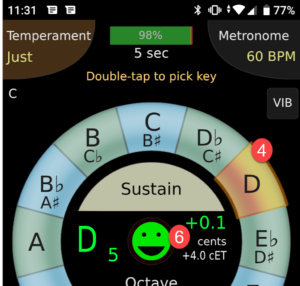So you have spent hours with the tuner trying to get your open G exactly in tune, and now your teacher wants you to play it 14 cents flat. What’s going on here? Read on to find out.
Equal Temperament (ET) Tuning in Bullet Points
5.946% is awkward to work with, so there is an alternate unit called cents. the 5.946% change between semitones is 100 cents. Suppose you are playing a C and your tuner says you are 50 cents sharp. That means you are half way between C and C#, so you are off by 1/2 semitone. There are 100 cents in a semitone, and 1200 cents in an octave.
The point of Equal temperament is to allow a keyboard instrument play in any key with minimal flaws in intonation.It replaced earlier systems based on more acoustically “pure” systems. (Just tuning is an one of these more pure systems.)
What is Just Tuning?
| Just | ET | |
|---|---|---|
| third | 5:4 (1.25) | 1.260 |
| fourth | 4:3 (1.333) | 1.335 |
| fifth | 3:2 (1.5) | 1.498 |
Perhaps the best way to compare Just tuning with ET is to show how much higher (or lower) Just tuning is than ET for the major scale. The difference in cents is usually called cET. It depends on the position in the scale, not the absolute name of the note.
| cET | |
|---|---|
| do | 0 |
| re | 3.9 |
| mi | -13.7 |
| fa | -2.0 |
| sol | 2.0 |
| la | -15.6 |
| ti | -11.7 |
| do | 0 |
One of the larger differences is on mi. If you are playing in C major, E=mi, so you should play it 14c flat. However, if you are playing in E major E=do, and you want to be right on pitch. That’s assuming your tuner is set for Equal Temperament. The attached table provides a more detailed comparison of Just and ET tuning, including a cET table for the complete chromatic scale.
Using Just Tuning in Tonal Energy Tuner
-
Select Preferences / Alternate Temperament
-
Go to the Sound screen
-
One final, very critical step – Tell TE Tuner what key you’re playing in.






Leave a Reply
You must be logged in to post a comment.